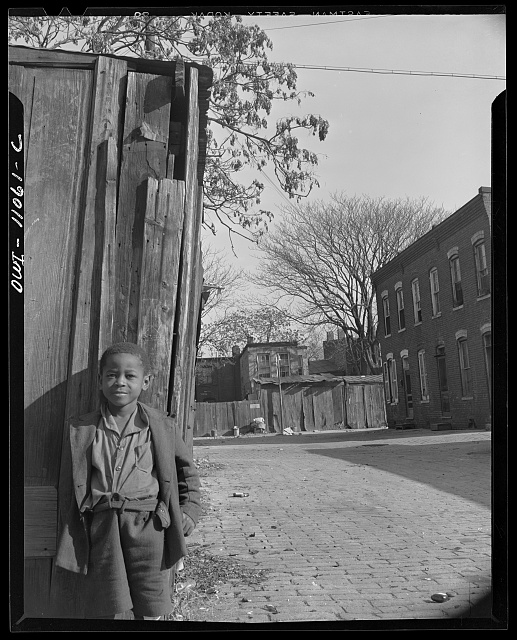
A boy poses in an inhabited Southwest alley. Photograph by Gordon Parks, courtesy of Library of Congress, Prints & Photographs Division, Farm Security Administration/Office of War Information Black-and-White Negatives
By Carolyn Swope and Thelma D. Jones
Southwest Neighborhood Assembly History Task Force Subcommittee on Black History
Before urban renewal began in the 1950s, Southwest DC was a tightly-knit, majority-Black working-class community. Oral histories tell us that residents knew their neighbors, pooled resources, and developed collective support networks to navigate the difficulties of high costs of living and racial discrimination in the city. Despite initial promises that new housing would be for the people who already lived in Southwest, most of it was built for middle- to upper-class residents instead, and the community was scattered and uprooted. Within the area of urban renewal, more than 23,000 people and 1,500 businesses were displaced and 99% of buildings were torn down.
It was hard to replace that community support, as one study found that, five years later, over a quarter of residents had not made a single friend in their new neighborhood. Because of that displacement and destruction, it can be difficult to sense what that community was like or find traces of history remaining in today’s neighborhood.
The photographs of Joseph Owen Curtis, a Southwest resident both before and after urban renewal, are well-known in Southwest – appearing, for example, on a new mural in Buzzard Point. They have been an invaluable window into what the Southwest community looked and felt like before urban renewal and after. However, other rich resources documenting this earlier community also exist. At an upcoming exhibit at Southwest Day, the Subcommittee on Black History of SWNA’s History Task Force will highlight two important photograph collections by Gordon Parks and Plater Gedney.
Gordon Parks
Gordon Parks (1912-2006) was a Black photographer who called his camera a “weapon” against “racism, intolerance, poverty.” As part of a New Deal initiative to document American life, especially the challenges that working-class people faced, he took many photographs of Southwest residents in 1942. The photographs are bursting with life: little boys shooting marbles outside, women washing clothes and preparing food in the kitchen of one-room flats, and families sitting down to eat dinner. The images help us see both how life in Southwest could be difficult for its residents, and at the same time, how families and neighbors worked together to make ends meet and find joy.
A new exhibit of Gordon Parks’ groundbreaking photographs on view from July 2024 through January 12, 2025 at the National Gallery of Art West Building, 4th Street and Constitution Avenue NW, Gallery G22. The exhibition, Gordon Parks: Camera Portraits, includes an image of a resident of Southwest alongside portraits of American icons such as boxer Muhammad Ali and conductor Leonard Bernstein.
Plater Gedney
Plater T. Gedney was hired by the Redevelopment Land Agency, which ran urban renewal, to appraise Southwest’s buildings, so they could compensate the owners when they seized and demolished them through eminent domain. In the mid-1950s, Gedney took pictures of each building in certain areas, and often made notes about their condition and value. Together, the photos create the equivalent to a “Google Street View” of some blocks. Some of the homes are grand historic buildings; others are modest. Some are in good repair, while others indicate how slumlords took tenants’ money without keeping up their units. Swings and gardens often appear in small front yards, showing how residents found ways to make space for connection and beauty even in small and crowded homes.
To view more of the Gedney photographs, residents can make an appointment at the DC History Center by emailing library@dchistory.org or calling (202)516-1363, ext. 302. The library is open for research appointments on Tuesdays and Thursdays, but can be arranged at other times if necessary. The DC History Center’s mission is to connect, empower and inspire. The librarian is available to walk you through the process of viewing these or any of our collections. Everyone is welcome.
Ready to See More?
SWNA’s History Task Force Subcommittee on Black History will display an exhibit at this year’s Southwest Comm-Unity Forum (Summer in Lansburgh) Saturday, August 24, from 12:00 p.m. to 8:00 p.m. at Lansburgh Park, 1098 Delaware Avenue SW. We hope that residents who have personal or family connections to some of the places and people in the photographs may come to see them. Photos from pre-urban renewal include parts of what are now Potomac Place, Capitol Park, Amidon Field, Greenleaf Gardens, Syphax Gardens, and more.
We also hope that the photographs can help current residents sense the enormity of what was lost. While Southwest’s residents deserved better housing, dismissing their community as “blighted,” demolishing it, and displacing residents – without preserving their community ties or building deeply affordable new housing – was not the answer. As Southwest faces redevelopment again, what can we learn from recognizing the scale of that loss and the mistakes that urban renewal made?
To share ideas or requests for resources or information from the SWNA History Task Force Subcommittee on Black History, please email thelma.d.jones@outlook.com.
Carolyn Swope, MPH is a PhD candidate at Columbia University researching recent gentrification and redevelopment in Southwest, how it relates to Southwest’s longer history, and the implications for Black residents’ health and well-being. Her ongoing research is based in both archival work and discussions with Southwest residents and leaders.
Thelma D. Jones, AAS, CHW, is a community activist serving in various leadership roles for more than four decades with the Southwest Neighborhood Assembly. A 17-year breast cancer thriver, she is also the founder of the Thelma D. Jones Breast Cancer Fund, an award-winning grassroots nonprofit in Southwest DC which advocates to improve the overall health and wellness for women and men through outreach, education, and support to reduce the incidences and mortality rates of breast cancer.

